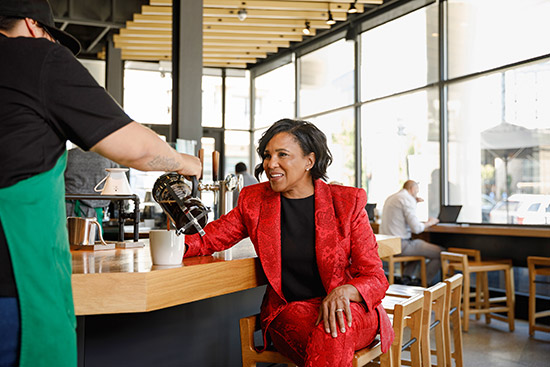
|
星巴克的運營總監(jiān)羅茲·布魯爾以前并不愛喝咖啡,。兩年前她剛加入星巴克時,,她最喜歡的含咖啡因飲料是茶(而且是冰綠茶)。 作為全球最大的咖啡公司的高管,,每天品鑒各種咖啡簡直是再日常不過的事,,星巴克的高管團(tuán)隊甚至還得經(jīng)常到哥斯達(dá)黎加的咖啡農(nóng)場開會。有些人可能會想,,在這樣一家公司當(dāng)二把手,,不愛喝咖啡怎么行? 不過自從干上這份工作,,布魯爾通過系統(tǒng)地學(xué)習(xí),,很快成為了一名大家公認(rèn)的合格咖啡師。她扔掉了自己所有的克里格膠囊咖啡機——膠囊咖啡機是所有咖啡發(fā)燒友的公敵,。她家的廚房里也擺滿了全套的“硬核”咖啡工具,。她經(jīng)常站在咖啡吧里,系著星巴克的綠圍裙,,練習(xí)調(diào)制馥芮白,,試驗怎樣才能把奶泡打得恰到好處。她最近正在挑戰(zhàn)手沖咖啡,,學(xué)習(xí)手沖咖啡是一個比較痛苦的過程,,需要你非常有耐心,要一邊攪拌,,一邊把水倒進(jìn)一個錐形的過濾器里,。她說:“在我做這件事時,我非常專注,,幾乎連呼吸都停止了,。” 好在星巴克之所以聘請她,,并不是看中了她做咖啡的技術(shù),。這也讓布魯爾可以從容練習(xí)。畢竟星巴克的員工里已經(jīng)有很多的咖啡專家了,。作為一名前沃爾瑪?shù)母吖?,布魯爾給星巴克帶來的,是像做手沖咖啡時一般的執(zhí)著和專注,,而此時的星巴克正迫切需要這種態(tài)度,。 |
Roz Brewer, chief operating officer of Starbucks, is not by nature a coffee person. In fact, when she joined the company two years ago, her caffeination vehicle of choice was tea (green and iced, thank you). Some might think that her apathy toward java could pose a problem for the newly appointed No. 2 of the world’s largest purveyor of the brew—a company where the slurps of tastings regularly echo through its Seattle headquarters and the executive team decamps to its very own coffee farm in Costa Rica for leadership meetings. But since taking the job, Brewer has methodically worked toward earning her barista bona fides. She threw out all of her Keurig coffeemakers—the nemesis of coffee snobs everywhere—and restocked her kitchen with hard-core coffee paraphernalia. She’s put on the Starbucks green apron and practiced her flat whites behind the coffee bar—getting that layer of microfoam just right. Her latest challenge: perfecting the pour-over, a task that requires a painful amount of patience and swirling as water drips slowly through a cone-shaped filter. “While I’m doing it, I’m so focused I can barely breathe,” Brewer says. While Starbucks waits for Brewer to master the technique, it helps that the company didn’t hire her for her espresso expertise. The Seattle giant already has plenty of coffee nerds on staff. What Brewer, a former Walmart executive, has brought to Starbucks is that uncompromising, pour-over-level focus—and at a time when the company desperately needed it. |
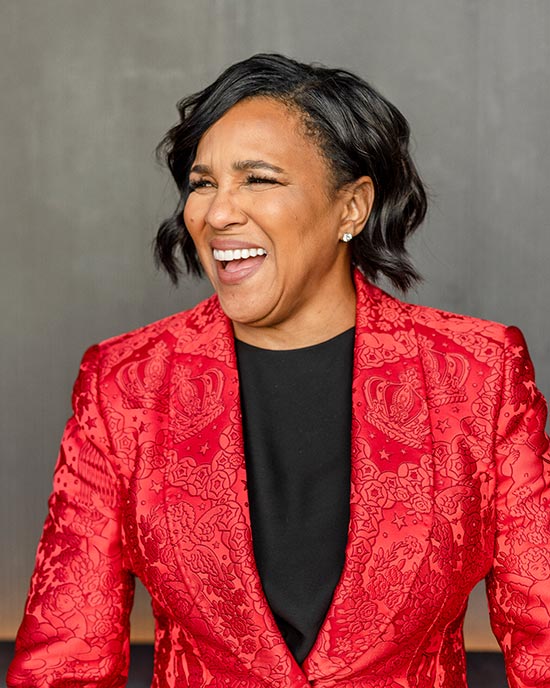
|
布魯爾在2017年10月被任命為星巴克的運營總監(jiān)兼美洲業(yè)務(wù)負(fù)責(zé)人,她負(fù)責(zé)的也是星巴克規(guī)模最大,、利潤最高的一塊業(yè)務(wù),。她進(jìn)入星巴克時,星巴克正在經(jīng)歷摩根大通的分析師約翰·伊萬可所稱的“公司歷史上最糟糕的幾個月”。在經(jīng)歷了連續(xù)五六年的銷量和門店數(shù)量增長后,,星巴克發(fā)現(xiàn)自己陷入了經(jīng)營混亂,,門店客流量平平。不久后,,星巴克又陷入了種族歧視爭議,。2018年4月,兩名黑人走進(jìn)了費城的一家星巴克,,結(jié)果該店經(jīng)理居然打電話報了警,。最重要的是,此事發(fā)生僅僅幾個月后,,星巴克品牌的創(chuàng)始人,、縱橫商界30多年的商界傳奇霍華德·舒爾茨宣布將從公司離職。 布魯爾就是在這個關(guān)鍵時期進(jìn)入星巴克的,,她的任務(wù)就是用自己在零售業(yè)的經(jīng)驗,,重整星巴克的門店,強化各級的組織紀(jì)律,。百事公司的前首席執(zhí)行官盧英德曾與布魯爾在沃爾瑪共事過,,現(xiàn)在兩人還是亞馬遜董事會的成員。她表示:“羅茲是一個強硬的人,,她很注重細(xì)節(jié),,她不愛夸夸其談,但總能把事情做好,?!?/p> 但布魯爾希望帶給星巴克的,不只是正確的門店運營方式,,她也是首席執(zhí)行官凱文·約翰遜的整張戰(zhàn)略藍(lán)圖的一部分,。約翰遜在“后舒爾茨時代”的基本理念,是要將星巴克從一家增長型公司轉(zhuǎn)型成一家“持久型公司”,。這意味著公司文化必須具備嚴(yán)肅性和一貫性,,同時要確保星巴克的33萬名門店員工(他們也是公司是的臉面)擁有恰當(dāng)?shù)墓ぞ撸蕴幚硭麄兛赡苊媾R的各種情況,。布魯爾曾在全球最大的零售企業(yè)工作過10年,,她深知一家全球性企業(yè)怎樣才能團(tuán)結(jié)一致地前進(jìn)。布魯爾表示:“有些領(lǐng)導(dǎo)者不會將自己的理念或者機會規(guī)?;?,但我在沃爾瑪學(xué)到了這一點?!?/p> 起初,投資界也有些人質(zhì)疑布魯爾并非星巴克運營總監(jiān)的上佳人選,,因為他們并不認(rèn)為布魯爾在零售行業(yè)的經(jīng)驗對星巴克這樣一個注重體驗和高觸感的品牌有什么幫助,。不過隨著星巴克的業(yè)務(wù)日趨好轉(zhuǎn),,這些質(zhì)疑的聲音也漸漸消失了。貝爾德公司的分析師大衛(wèi)·塔倫蒂諾指出:“事實已經(jīng)證明,,那些質(zhì)疑她的人看走眼了,。” |
Brewer took on the job of COO and head of the Americas business—the company’s biggest and most profitable—in October 2017, just as the company entered what J.P. Morgan analyst John Ivankoe has described as a “terrible few months in the company’s history.” After an unprecedented run of sales and store growth lasting more than half a decade, store traffic flatlined as the company found itself in operational chaos. Then, in April 2018, the company faced accusations of racial bias after a manager called the police on two black men in one of its Philadelphia stores. But the icing on the cake—or frothed milk on the macchiato, as it were—was the announcement just months later that Starbucks executive chairman Howard Schultz, one of the business world’s most storied leaders and the embodiment of the Starbucks brand for more than three decades, would leave the company. It was during this critical period that Brewer entered the fold, tasked with translating her retail expertise into cleaning up the company’s stores and imposing a level of discipline that has become her calling card. “Roz is a tough cookie,” says Indra Nooyi, the former CEO of PepsiCo who did business with Brewer when she was at Walmart and now serves with her on the Amazon board. “She’s into the details. She’s not a fluffy person. She gets things done.” But the structure and focus that Brewer is attempting to bring to the company goes beyond just getting store operations right. It’s an essential part of CEO Kevin Johnson’s vision as he lays the groundwork for Starbucks in the post-Schultz era, a Starbucks that is less of a growth company and more of what he describes as an “enduring” one. That means bringing rigor and consistency to the company’s culture, as well as guaranteeing that its more than 330,000 store employees—the company’s public face—have the tools to properly handle any situation. The 10 years Brewer spent at not only the world’s largest retailer but also the world’s largest company taught her a little something about what it takes for a global operation to move in lockstep. “Some leaders have difficulty scaling their ideas or an opportunity,” Brewer says. “I learned that at Walmart.” Brewer’s appointment has not come without its critics in the investment community, who initially could not see how her big-box experience at Walmart translated into an experiential, high-touch brand. But as the business has started to turn a crucial corner, the questions have waned. Says Baird analyst David Tarantino: “To the extent there were skeptics, they’ve been proven wrong.” |
****
|
當(dāng)約翰遜給她打電話邀請她來擔(dān)任星巴克運營總監(jiān)時,,她完全沒有心情談工作的事,。當(dāng)時她正在納帕度假,想在找到下一份工作前再放松一陣子,。 當(dāng)時,,布魯爾剛剛結(jié)束了她在沃爾瑪?shù)?0年歲月,她在沃爾瑪?shù)淖詈笠粋€職務(wù),,是山姆會員商店(Sam’s Club)的首席執(zhí)行官,,任期5年。布魯爾在沃爾瑪是一顆耀眼的明星,,在職務(wù)上也是一路高歌猛進(jìn),,沒過幾年,就從喬治亞州的業(yè)務(wù)負(fù)責(zé)人,,成了東南大區(qū)負(fù)責(zé)人,,然后是美東地區(qū)負(fù)責(zé)人,直至最后成為全美山姆會員商店業(yè)務(wù)的負(fù)責(zé)人,。 布魯爾表示,,2016年沃爾瑪以33億美元收購Jet.com后,她有了一種預(yù)感,,覺得以后山姆會員商店的重要性會逐漸降低,。沃爾瑪本身也在尋求改變。布魯爾是在山姆會員商店干得最久的首席執(zhí)行官了,。在她領(lǐng)導(dǎo)下,,山姆會員商店雖然再怎么努力也沒能趕上更強大的競爭對手開市客(Costco),不過也實現(xiàn)了一定的增長,。愛德華瓊斯公司的分析師布萊恩·雅伯勒認(rèn)為:“山姆會員商店做得還是不錯的,,但它并沒有點燃整個世界?!?/p> 布魯爾第一次見到舒爾茨就是在沃爾瑪,,當(dāng)時,舒爾茨來到沃爾瑪總部出席商業(yè)活動,,他要與沃爾瑪?shù)氖紫瘓?zhí)行官董明倫在一群員工面前談話,。然而活動馬上就要開始時,董明倫突然有事無法出席,布魯爾只好代替他參加了活動,。她與舒爾茨一見如故,。不久之后,舒爾茨就請她擔(dān)任星巴克的董事,,布魯爾一開始拒絕了他——當(dāng)時她已經(jīng)是洛克希德馬丁公司的董事了,。不過在她從沃爾瑪離職后,她又重新考慮了這個提議,。2017年年初,,星巴克正式宣布布魯爾加入該公司的董事會。 在她加入星巴克董事會后不久,,有一次剛開完董事會議,,她便登上了前往納帕的航班,想來一次久違的休假,。結(jié)果這次葡萄酒之鄉(xiāng)之旅突然被一通來自星巴克的電話打斷了,。布魯爾本來還有些后悔,覺得星巴克的董事會真難伺候,。結(jié)果來電話的人是約翰遜,,他請她回到西雅圖,說說讓她當(dāng)運營總監(jiān)的事,。 在當(dāng)時,,布魯爾并不是一個顯而易見的選擇。她說:“如果沒有人推薦,,我自己去面試,,那能入選的話就是奇跡了?!钡切前涂说亩聲蓡T經(jīng)過這幾次開會,,已經(jīng)認(rèn)可了她的務(wù)實和嚴(yán)謹(jǐn)。Ariel投資公司的聯(lián)席首席執(zhí)行官,、星巴克的副董事長梅洛迪·霍布森表示:“她是一個搞運營的人,。她不僅有看法、有眼界,,而且有執(zhí)行力,。”而這些正是約翰遜需要的,。約翰遜上臺后的一項重要舉措,,就是給星巴克的重點業(yè)務(wù)“瘦身”。比如他砍掉了泰舒茶等一些非核心業(yè)務(wù),,關(guān)停了茶瓦納零售門店,。他從上到下地推動精簡改革,,并且需要有人對星巴克的所有門店進(jìn)行同樣的改革。約翰遜表示:“她懂如何大規(guī)模有秩序地運營,?!辈剪敔栐谖譅柆敁?dān)任美東地區(qū)負(fù)責(zé)人時,她管理的業(yè)務(wù)的銷售額超過1000億美元,,幾乎是整個星巴克的四倍。 布魯爾同意花一個周末的時間,,在西雅圖與約翰遜商量這件事,。不過這份工作來的時機不太好。她和家人剛從沃爾瑪總部所在的本頓維爾搬到了亞特蘭大,,并且在那兒蓋了一座房子,。最近,還有一家私募股權(quán)公司想請她去當(dāng)首席執(zhí)行官,。布魯爾也認(rèn)為,,那是一份相對容易的工作。不過布魯爾從不隱藏自己的雄心壯志,,她是無法對星巴克這樣一家標(biāo)志性的公司說“不”的,。最終,她拒絕了那家私募公司,,成了約翰遜的副手,。 |
When Brewer got the call from Johnson about the COO job, she was in no mood to think about reentering corporate America. Actually, she was in no mood to talk business at all. She was on vacation in Napa, trying to unwind while she took some time off before her next move. Brewer had just wrapped up her decade at Walmart, her most recent role there a five-year stint as CEO of the company’s warehouse membership business, Sam’s Club. She had become a star at the retailer, skyrocketing up the ranks from running Georgia, to the Southeast business, and then to all of Walmart’s Eastern region before being tapped to lead Sam’s. But after Walmart acquired online retailer Jet.com for $3.3 billion in 2016, Brewer says she could see the writing on the wall: She expected Sam’s to become less of a priority. Walmart may very well have been looking for a change too. Brewer was Sam’s longest-serving CEO, and the division had seen only modest growth on her watch as it tried and failed to catch bigger rival Costco. “Sam’s did okay,” says Edward Jones analyst Brian Yarbrough, “but it wasn’t lighting the world on fire.” Walmart was where Brewer first met Schultz, who was visiting the company’s HQ for an interview with CEO Doug McMillon in front of an audience of employees. McMillon had to cancel at the last minute, so Brewer stepped in, and the two hit it off. Schultz broached the possibility of a director role soon after, but Brewer—already a director at Lockheed Martin—initially put him off. After leaving Walmart, she reconsidered; Starbucks announced Brewer was joining its board in early 2017. It was after one of her early board meetings that she hopped that flight to Napa for some much-needed R&R. So when her wine country respite was interrupted by a call from Starbucks, Brewer cringed, worried that she had just signed herself up for a high-maintenance board. Instead, it was Johnson asking her to come back to Seattle so they could discuss the COO job. Brewer wasn’t an obvious choice. “If I were to interview raw, it would have been a leap of faith,” she says. But her fellow directors had already seen how she was willing to get into the nitty-gritty during board meetings. “She’s an operator,” says Mellody Hobson, co-CEO of Ariel Investments and Starbucks vice chair. “She’s not just a person with a point of view and vision. She can execute.” It’s just what Johnson needed. One of his first big moves as CEO was narrowing Starbucks’ focus. He had rid the portfolio of noncore businesses—selling Tazo tea and closing its Teavana retail stores. He was simplifying the company from the top and needed someone to do the same across the entire store base. “She knows how to operate with discipline at scale,” he explains. At one point at Walmart, Brewer, as head of the Eastern division, was running a business with more than $100 billion in sales, about four times the size of all of Starbucks. Brewer agreed to spend a weekend in Seattle talking it over with Johnson, but the timing of the offer was all wrong. She and her family had just finished building a house in Atlanta, where they had relocated from Walmart headquarters in Bentonville, Ark. She had recently been offered the CEO job at a private equity firm—a role, she says, that would have been easy. But Brewer, who has never hidden her ambition, couldn’t say no to a company as iconic as Starbucks. In the end, she turned down the CEO gig to become Johnson’s No. 2. |
****
|
如果在離開沃爾瑪之后,布魯爾追求的是簡單輕松的生活,,那她來星巴克就是來錯了地方,。她剛一上任,就面臨客流量停滯不前,、同店銷量增長緩慢的問題,。在上任后前三個月,布魯爾什么都沒有干,,一心學(xué)習(xí)業(yè)務(wù),。“我很快就發(fā)現(xiàn),,當(dāng)前的模式是有問題的,,于是我說:‘先不要做決定,因為情況很敏感,?!彼芸炀驮\斷出,癥結(jié)主要出現(xiàn)在咖啡臺的后面,。近幾年,,星巴克的網(wǎng)上訂單出現(xiàn)了巨大增長,,顧客到達(dá)門店之前,就可以用過手機APP下單,。但星巴克尚未學(xué)會應(yīng)對網(wǎng)上訂單的急劇增長,。結(jié)果就是等待取飲品的顧客經(jīng)常排成長隊,咖啡師們手忙腳亂地調(diào)配一杯杯的拿鐵和星冰樂,,這一幕在星巴克簡直司空見慣,。 在舒爾茨時代,星巴克的領(lǐng)導(dǎo)風(fēng)格很注重直覺和本能,。但是約翰遜有技術(shù)背景,,布魯爾曾學(xué)過化學(xué),他們更注重分析數(shù)字,。布魯爾分析了訂單數(shù)據(jù)后發(fā)現(xiàn),,門店員工有40%的工作時間花在了與顧客無關(guān)的任務(wù)上——比如每天要數(shù)三次還剩下多少罐裝牛奶,或者是補充用掉的咖啡紙杯,,并且把它們撂得高高的,。星巴克美國零售業(yè)務(wù)負(fù)責(zé)人莎恩·威廉姆斯戲稱他們這是在蓋“比薩斜塔”。 布魯爾和她的團(tuán)隊采取了一些方法消除,、簡化或者用自動化手段替代這些任務(wù),,好讓員工將更多時間花在顧客身上。如果有的門店的網(wǎng)上訂單很多,,就會有一名咖啡師專門負(fù)責(zé)制作這些訂單的咖啡,。清潔工作也從白天挪到了打烊之后。 不只是門店員工忙得手忙腳亂,。布魯爾表示,,她最終將公司正在進(jìn)行的項目砍掉了三分之二。她還給公司設(shè)定了三個優(yōu)先目標(biāo):飲品創(chuàng)新,、門店體驗和數(shù)字業(yè)務(wù),。“我們統(tǒng)一了大家的共識,,如果有什么東西與這三個目標(biāo)不符,,我們就會叫停它?!爆F(xiàn)在公司里都知道她是一個能做出艱難的決策并且貫徹到底的人,。比如,星巴克在2017年大張旗鼓地推出的新鮮食品項目Mercato,,曾一度進(jìn)入6個市場的1500多家門店,,這個項目現(xiàn)在已經(jīng)被叫停了。布魯爾和她的團(tuán)隊撰寫了一份6頁的白皮書,,詳細(xì)分析了該項目的優(yōu)缺點,,同時指出了公司面臨的最大問題和挑戰(zhàn),。結(jié)果很明顯,Mercato業(yè)務(wù)并不符合公司的三大優(yōu)先目標(biāo),,于是它被斃掉了,。 星巴克還削減了一些限時供應(yīng)的飲品。這種飲品有的也曾火過一段時間,,比如曾經(jīng)紅遍Instagram的獨角獸星冰樂,。它們雖然火爆一時,但日常銷量并不足以支撐起一家咖啡企業(yè),。星巴克的研發(fā)團(tuán)隊將精力放在了那些可以被做成不同口味和版本的飲品上,,比如氮氣咖啡、綿云冷萃等等,,而不是像獨角獸星冰樂這種單一配方的產(chǎn)品。研發(fā)人員使用的原料,,主要是門店里的現(xiàn)有產(chǎn)品,,以免使咖啡師的工作變得過于復(fù)雜。比如說蛋白質(zhì)冷萃奶昔理論上是個好東西,,但是把它需要的5種原料調(diào)和在一起,,流程過于復(fù)雜,難以執(zhí)行,。 |
If easy was what Brewer was looking for in her post-Walmart life, Starbucks wasn’t it. Her welcome present was flat store traffic and slowing same-store sales growth, an important industry metric. For the first 90 days Brewer did nothing but study the business. “I knew right away that this was problem mode, so I said, ‘No decisions because this thing is fragile,’?” she says. She quickly diagnosed the issue: The company was melting down behind the coffee bar. Starbucks had seen massive growth in its mobile order and pay business, enabling customers to order via their app before arriving in the store, but the company didn’t know how to handle the resulting deluge of orders. The ensuing scene became a familiar one in Starbucks stores: Customers clamoring over one another as they waited to pick up their drinks at what Starbucks calls the “hand-off plane,” and panicked baristas trying to keep up with the onslaught of lattes and frappuccinos. Under Schultz, Starbucks had often been a place led by intuition and instinct. But Johnson, with his background in tech, and Brewer, who trained as a chemist, turn more readily to the numbers. So Brewer looked at the research as she set her sights on imposing order on the stores. She discovered that 40% of employees’ time was spent on tasks away from the customer—counting milk jugs three times a day or unnecessarily restocking the floor to create what Rossann Williams, head of Starbucks U.S. retail, jokingly calls “the Leaning Tower of Pisa” of cups. Brewer and her team moved to eliminate, simplify, or automate tasks so those hours could instead be spent with customers. Stores with the most mobile orders got a barista exclusively dedicated to making those drinks. Cleaning was moved from daytime to after close. It wasn’t just store employees who had too many balls in the air. Brewer says she ended up killing two-thirds of the projects in progress at corporate. She set three priorities: beverage innovation, store experience, and the digital business. “We just lined everybody up and said if it doesn’t fit in these three lanes, we’re stopping the work,” she says. She gained a reputation for making tough decisions and sticking to them. One of those was to end Mercato, the company’s fresh-food efforts, rolled out with great fanfare in 2017 and ultimately introduced in 1,500 stores across six markets. Brewer had her team put together a six-page white paper breaking down Mercato’s pros and cons—an exercise she undertakes with all of the company’s biggest problems and opportunities. The results were clear: It doesn’t fit with the company’s priorities—kill it. Starbucks also cut back on limited-time offers, which had produced rare one-off hits like the Instagram-famous Unicorn Frappuccino. They created buzz but not the routine purchases that drive a coffee business. The R&D team switched its efforts to products that could be made in different flavors and versions—like nitro coffee or cold foam—rather than stand-alone items like the Unicorn. Developers worked with ingredients already in the stores to make sure they didn’t overcomplicate the baristas’ work. Protein cold-brew shakes were great in theory, but putting together the more than five ingredients they required was too complex to execute. |
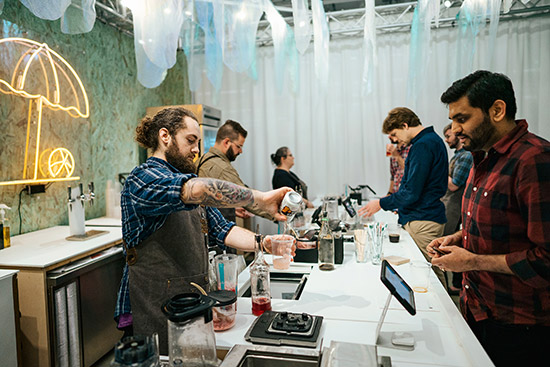
|
影響門店客流量增長的最大因素,,是每天下午的業(yè)務(wù)。布魯爾再次向數(shù)據(jù)尋求答案,。她發(fā)現(xiàn),,星巴克的銷量增長,基本上全部來自于它的“星巴克星享俱樂部”會員計劃,。該項目的1720萬名參與者都是星巴克的忠實客戶,,這些客戶對公司來說極為寶貴,雖然只有四分之一的星享客戶每月都會來店消費,,但他們貢獻(xiàn)的銷量卻達(dá)到了40%,。還有一些顧客雖然不是星享俱樂部的會員,但他們平均每月在星巴克消費1到5次,,占據(jù)了午后客流的相當(dāng)一部分比例,。下午2點以后來店消費的人群更喜歡冷飲。目前冷飲的銷量已經(jīng)占到了星巴克飲品總銷量的50%左右,。 為了解決下午客流量的問題,,該團(tuán)隊在各個層面都采取了一些措施,。研發(fā)團(tuán)隊集中精力開發(fā)冷飲,一些比較有經(jīng)驗的咖啡師也從上午上班調(diào)整為下午上班,。最重要的是,,數(shù)字團(tuán)隊正在想方設(shè)法將下午來店消費的顧客變成星享會員。比如他們會要求Wi-Fi用戶提供電子郵件地址,,然后針對他們開展推廣,,以吸引他們加入星享俱樂部。上一季度,,星巴克下午2點以后的客流量出現(xiàn)了三年來的首次上漲,,星巴克也實現(xiàn)了最高的同期銷量增長率。 布魯爾雖然是一個數(shù)據(jù)狂人,,但她也十分注重人際接觸,。她花了很多時間走訪星巴克的各個門店。在那里,,她不光會數(shù)汽車窗口的訂單數(shù)量,,或者咖啡師做了多少食品,還會看看那些認(rèn)出她的員工會不會直視她的眼睛,?!叭绻麄兊皖^看自己的腳,就說明他們并不為這家店感到驕傲,。99%的情況下,,我的判斷都是對的?!?/p> |
One of the biggest drags on the company’s store traffic was its afternoon business, and Brewer again turned to the data to understand why. Starbucks had been getting all of its sales growth from customers in its membership program, Starbucks Rewards. The 17.2 million loyalists who are now part of the program are extremely valuable to the company, accounting for more than 40% of sales but only about a quarter of the customers who come into the store every month. Occasional visitors, who frequent a store on average one to five times per month, made up a disproportionate amount of the afternoon traffic. The post-2 p.m. crowd and these occasional customers also prefer cold drinks, which now comprise about 50% of beverage sales. The team attacked the afternoon problem at all levels: R&D lasered in on cold beverages; more experienced baristas, who normally work in the morning, were redeployed to the afternoon. And perhaps most significantly, the digital crew focused on converting midday customers into rewards members, asking Wi-Fi users for their email addresses and then targeting them with promotions to entice them to sign up for the program. Last quarter, business after 2 p.m. grew for the first time in three years, and the company reported its best sales growth over the same period. Brewer may be a data fiend, but she’s also a high-touch executive; she spends a good chunk of her time visiting various stores. She’s not just counting orders or how many food items baristas move. What she wants to see is whether employees who recognize her will look her in the eye. “If they look down at their feet, they’re not proud about the store,” Brewer says. “Ninety-nine percent of the time I’m right about that.” |
****
|
2018年4月,,兩名黑人男子在費城的一家星巴克里被捕。當(dāng)時他們并沒有買東西,,只是在等一個朋友,,因此不愿意從店里離開,結(jié)果經(jīng)理打電話報了警,。圍觀群眾將事發(fā)經(jīng)過以及兩人被捕的畫面放在了網(wǎng)絡(luò)上,,結(jié)果在全美范圍內(nèi)引起了一場對種族歧視的聲討,一些人甚至呼吁抵制星巴克,。 這起事件被星巴克委婉地稱為“費城事件”,,它給布魯爾也造成了不小的打擊。布魯爾的兒子年齡與被警察帶走的兩名黑人男子相仿,。作為一個黑人男孩的母親,,布魯爾也感到了一種“母性的恐懼”。她在參加母校斯佩爾曼學(xué)院2018年畢業(yè)典禮時解釋道:“我一直在瘋狂地努力奮斗,,瘋狂地捍衛(wèi)這家我深深喜愛的公司,,而為了捍衛(wèi)它,,我必須直面我深愛的黑人社會?!辈剪敔柡图s翰遜親自飛到費城向這兩名男子道歉,。后來星巴克還向公司的17.5萬余名員工開展了反種族歧視培訓(xùn),在這個過程中,,她也發(fā)揮了重要作用,。 |
In April 2018, two black men were arrested in a Philadelphia Starbucks. They hadn’t made a purchase while they waited for a friend to arrive, and the manager called the police when they declined to leave the store. The video that onlookers posted on social media of the exchange and ensuing arrest set off a national firestorm about racial profiling, with some calling for a Starbucks boycott. The “Philadelphia incident,” as it’s delicately called around Starbucks, hit Brewer hard. Her son is about the same age as the two men who were removed from the store, and it evoked in her what she describes as the “motherly fear” she’s always had raising an African-American male. “I was mad to have fought so hard for so long, mad to have to defend my company that I deeply admire, and I had to defend it to the African-American community that I profoundly love,” she explained while delivering the 2018 commencement address at Spelman College, her alma mater. Brewer and Johnson flew to Philadelphia to apologize to the two men in person, and she became instrumental in putting together racial bias training for 175,000 of the company’s employees. |
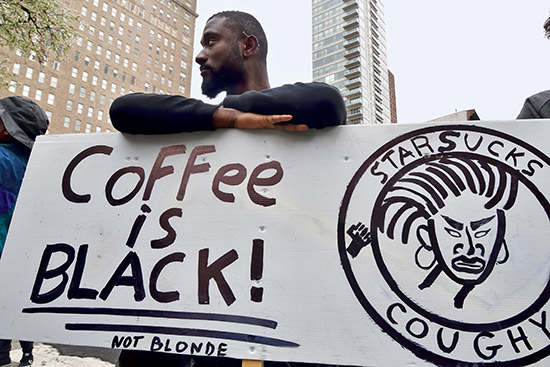
|
布魯爾并不避諱談?wù)摲N族問題,特別是女性和黑人群體中,,本來就很少有人在事業(yè)上能達(dá)到她的高度,。不過在談到這個問題時,有時她只是幽默地帶過,,有時人們也能感受到她的痛苦。比如有一次她去參加會議,,列席者都是首席執(zhí)行官,,有一位首席執(zhí)行官可能把她當(dāng)成了一個市場營銷員或是小商販,總之他覺對想不到,,她竟然是山姆俱樂部的首席執(zhí)行官,。當(dāng)看到她登臺講話時,那位首席執(zhí)行官的表情簡直可以用呆若木雞來形容,。想起這件事,,布魯爾忍不住笑了起來。而在佩爾曼學(xué)院的畢業(yè)典禮上,,回憶起有一次她接受CNN采訪談到了企業(yè)的人才多元化問題,,之后很多人要求她辭職,甚至對她和她的家人發(fā)出死亡威脅,,不禁潸然淚下,。 作為一個在底特律長大的孩子,布魯爾從未想象過自己會走這條路,。在她小時生活的社區(qū)里,,黑人醫(yī)生或律師就算是黑人里的高端職業(yè)人士了,她曾以為自己未來也會走類似的路,。當(dāng)時她的父母都在通用汽車工作,,他們連高中都沒有上過,,但卻堅持讓5個孩子都讀了大學(xué)。有一段時間,,布魯爾的父親要同時打三份工,,才能供所有的孩子完成學(xué)業(yè)?!拔抑雷约翰荒苁?。”她說,。 |
Brewer does not shy away from talking about race, and especially about being one of the few double minorities—both black and female—to reach her level in business. Sometimes she does it with humor and sometimes with pain. She laughs recalling the look of dawning recognition on the face of the executive who had pinned her as a marketer or merchandiser—anything but the CEO of Sam’s Club—when she stood to give the keynote at a CEO confab. She choked up during the Spelman commencement, recalling the demands for her resignation and the death threats she and her family received when she talked about the business case for corporate diversity during a CNN interview. As a kid growing up in Detroit, Brewer never imagined this path for herself. The black professionals in her neighborhood were doctors and lawyers, and she thought she had a similar future. Her parents, both of whom worked for General Motors and had not graduated from high school, insisted that all five kids go to college. At one point, Brewer’s father was working three jobs to put all the kids through school. “I just knew I couldn’t fail,” she says. |
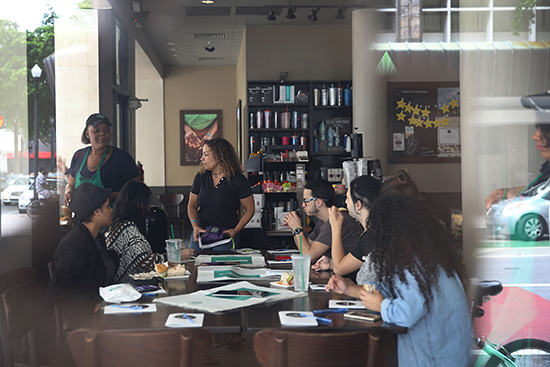
|
從斯佩爾曼學(xué)院畢業(yè)10天后,,布魯爾開始在金百利克拉克公司當(dāng)化學(xué)實驗員,。這是一項很孤獨的工作。布魯爾自詡是個“健談”的人,,但是“那里并不是一切開始的地方,,我甚至連個說話的人都沒有?!焙髞?,布魯爾被一支做收并購的盡職調(diào)查團(tuán)隊挖過去搞專利評估,從而轉(zhuǎn)向了商業(yè)領(lǐng)域,。一開始,,她負(fù)責(zé)的是一項價值1億美元的肥皂業(yè)務(wù)。15年后,,她已經(jīng)成了一家全球性企業(yè)的總裁,,公司所有的生產(chǎn)都?xì)w她管。不過,,當(dāng)沃爾瑪打來電話挖人時,,她還是決定跳槽過去,她不愿意在一家公司耗費自己的一生,。 布魯爾是山姆俱樂部的第一位黑人和女性首席執(zhí)行官,,是第一位在星巴克獲得如此之高的職務(wù)的黑人女性……她已經(jīng)打破了不少紀(jì)錄,對此,,她感到的更多是驕傲,,但這種名聲反過來也限制了她?!八屛腋杏X我好像不能犯罪似的,,我也經(jīng)常不能隨心所欲地放松。” 在“費城事件”后,,布魯爾一直在思考成功的概念,,以及怎樣通過運營使公司蒸蒸日上。她表示:“我們很忙,,我們正處于轉(zhuǎn)型的過程中,。但我們所能做的最重要的事,就是面對現(xiàn)實,。同時我們要說,,我們不僅要解決門店里面發(fā)生的事,還必須解決門店外面發(fā)生的事,,因為它會從外面走到里面,。你不可能把這兩件事分開?!?/p> 今年早些時候,,布魯爾向星巴克的美國零售業(yè)務(wù)負(fù)責(zé)人威廉姆斯提了一個問題,如果星巴克想創(chuàng)造行業(yè)內(nèi)最好的工作,,那么,,那份工作干起來應(yīng)該是什么樣的?對這種問題,,答案肯定是“我們永遠(yuǎn)在路上”之類的,。不過有此一問之后,星巴克確實在今年9月推出了一系列員工福利,,比如提高員工的心理健康福利,。威廉姆斯表示:“目前的情況是,如果你未來真想蓬勃發(fā)展,,而不是勉強生存下去,我們就必須找到一種方法,,讓門店里的工作變得更有意義,。”這并非只是一種“精神勝利法”,。更快樂的員工,,的確會讓顧客變得更快樂,從而帶來更高的銷量,。 “費城事件”也讓星巴克開始反思,,一家星巴克咖啡店究竟代表了什么。布魯爾指出,,像咖啡廳這種零售場所,,本質(zhì)上已經(jīng)與圖書館這種公共空間沒有什么區(qū)別了,它也必須滿足員工和當(dāng)?shù)厣鐣男枰R虼?,在有些地方,,?jīng)理們在洗手間里放一個針盒,用來處理吸毒者用過的注射器,,也是十分必要的,,只要他們覺得這樣做可以提高安全性。布魯爾還表示,,有些咖啡師能調(diào)制出完美的馥苪白或者手沖咖啡,,不過她希望這些咖啡師還能接受其他方面的培訓(xùn),比如學(xué)習(xí)如何應(yīng)對一些最困難的社交場合,,從而使大家增強對星巴克的歸屬感,。 這一切貌似與咖啡無關(guān),卻又有關(guān),。對布魯爾來說,,這可能也是星巴克目前還有的最大的一個機會了。 ? 本文原載于《財富》雜志2019年10月刊,。 ? 譯者:樸成奎 |
Ten days after graduating from Spelman, Brewer started as a bench chemist at Kimberly-Clark. It was lonely work. “It was not where things were happening, not even a conversation,” says Brewer, who describes herself as “a talker.” After being brought on by the M&A due-diligence team to assess patents, Brewer switched over to the business side, at first running a $100 million soap operation. Fifteen years later all of manufacturing fell under her purview as a global president. When Walmart came calling, she decided to make the move; she couldn’t bear the thought of working at one company her entire life. The barrier-breaking headlines that Brewer would go on to garner—the first woman and first African-American CEO of Sam’s Club, the first woman and first African-American to hold such a senior position at Starbucks—make her proud more than annoy her, but they also confine her. “It makes me feel like I can’t screw up,” she says. “I can’t always let my hair down the way I want to.” In the wake of the Philadelphia incident, it’s clear that the idea of success—and what it means to run a thriving company—has been on Brewer’s mind. “We were busy. We were in the middle of a turnaround,” she says. “But probably the most important thing we can do is face the reality and say, ‘Not only are we going to fix what happens in the store, we’ve got to fix what’s happening outside the doors because it’s coming inside.’ You can’t separate those two things.” Earlier this year, she posed a challenge to Williams, head of U.S. retail: If the company were to create the best jobs in the industry, what would that look like? The answer will always be a work in progress, but that query led Starbucks to announce a new round of employee perks in September, including enhanced mental-health benefits. “We’re really in this mode of, if we’re going to thrive in the future, not just survive, we’ve got to figure out a way to make the jobs in our stores so meaningful,” says Williams. “It’s really that personal to her.” It’s not just a feel-good philosophy. Happier employees lead to happier customers and higher sales. What happened in Philadelphia has also led the company to double down on what it means to be a Starbucks. The reality of retail right now, Brewer says, is that stores are essentially a public space like libraries and must serve the needs of their employees and community. In some locations, that’s even meant letting managers install needle boxes to dispose of drug users’ syringes in restrooms if they think it will increase safety. Brewer wants baristas to make the perfect flat white or pour-over. But she also wants them trained in how to deal with the hardest social situations they could possibly encounter so everyone feels like they belong in a Starbucks. It has nothing and everything to do with a cup of coffee. And to Brewer, it’s perhaps the single biggest opportunity the company still has.? This article originally appeared in the October 2019 issue of Fortune. |
?






